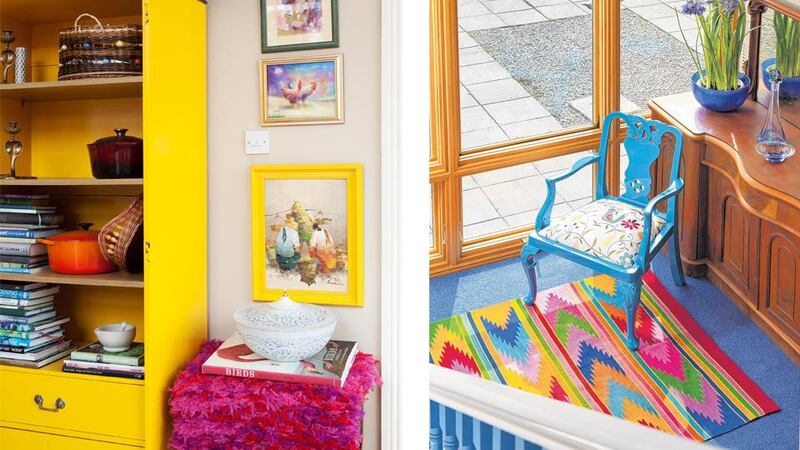Benedict & Beatrice founder Ann Mooney has set up a Betty Ford style clinic for old, unloved furniture in Ballymore Eustace. Using her own seven-step programme, she gives a voice to bit-part effects turning them into statement pieces that can command centre stage in any home.
From her Co Kildare home, Mooney offers sanctuary to old furniture. Washed-up, broken pieces are reborn as each undergoes her refurbishment and becomes a Benedict & Beatrice piece. It takes a lot of elbow grease, she says, and it’s dirty work.
“For me it’s like therapy. By taking something that is dusty and abandoned I get to bring it, Lazarus-like, back to life.”

Treatment takes place in her single-storey cottage that has been super-sized to include a large open-plan kitchen, living, dining room that has been Christened the Millennium Wing, because it was built it in 2000.
From the inside, the extension looks and feels like a barn conversion. Light streams through a wall of glazing is 20ft high. French doors open outside and a bank of windows above the doors open.
In pride of place is a cerise pink lacquered buffet that she bought at an auction at The Elms in Punchestown.
This is the sideboard that inspired her to set up her business. Through the work of her painter and a bold colour choice, the chunky and forlorn late-Victorian oak piece was given a fresh face, transforming it into something desirable. She was “gobsmacked” at how well it turned out.
Together with a friend, cabinet maker Philip Moloney, she started to buy old pieces at auction; repairing, restoring and rethinking them. “In the early days we bought pieces that needed a huge amount of work – new legs for chairs, for example – but we got smarter. Now we’re far more selective. Each piece gets a thorough inspection. We look for anything that’s missing from raised carved pieces, to unwelcome additions like woodworm.”
Although she researches online, Ann doesn’t buy until she has given each piece a thorough in-the-flesh examination.
“You have to go to the viewings and get up close and personal with the pieces rather than just trooping in on the day. I usually mark out four or five lots I’m interested in, take a closer look at them and decide the price I’m prepared to pay. I no longer get distracted by the rest of the catalogue.”
Mooney works in the marketing department of Marvin Architectural, a windows and doors company, and through her job travels weekly to their head office in Chiswick, London, where she attends the local auction rooms in her spare time. Marvin’s warehouse is nearby and she has permission to store her buys there until she has accumulated enough to transport them back to Kildare for treatment.
Each purchase has to become a piece you’d respond to in any room, she explains.
“Sideboards are a best-seller but they can’t be too broad or bulky. They have to fit in most people’s hallways and reception rooms. Occasional chairs and dressing tables also sell well.”
She buys in Ireland, too. A gentleman’s wardrobe, part of the contents of Tinode House in Blessington, Co Wicklow, has been overhauled. By taking off the doors, painting it canary yellow and adding horizontal shelving, she’s created a really cool-looking dresser. She found the exact colour she wanted in a magazine, tore out the page and had the colour mixed to match.
She refuses to give up on these old pieces: "Some say they belong to the past. Thanks to my rehabilitation programme and my respect and reverence for their makers, they have now a role to play in modern homes."
Ann Mooney's pieces will be on show at the Marvin show rooms, 71-72 Grove Road, Rathmines, Dublin 6 on Saturday October 12th from 10.30am to 3pm.
See benedictandbeatrice.com
WANT TO STAGE A FURNITURE INTERVENTION?
FOLLOW ANN MOONEY’S SEVEN-STEP PROGRAMME
1.First clean the piece, stripping it of varnish using Nitromors, a chemical application that dissolves varnish and wood stain.
2. Scrape or scrub by hand using a wire brush.
3. Repeat the cleaning process this time using sugar soap.
4. Sand down several times, first using coarse sandpaper and finishing with a fine grade paper.
5. Each piece of furniture gets two layers of undercoat. Each coat is a primer which creates a certain amount of elasticity that prevents the paint from chipping. Sand again between coats.
6. Only then do you apply colour. Ann uses a spray paint because she doesn't want brush marks on the furniture.
7. Some woods need a second coat. If it does then buff before you apply. The piece should now look like glass.















